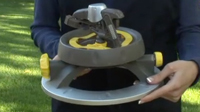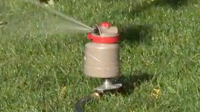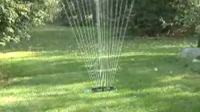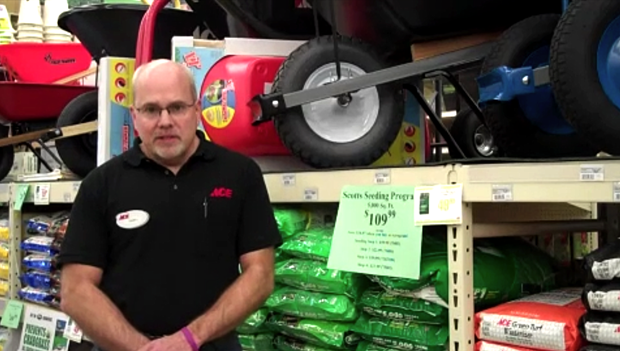You don't the permission to view this video
This video will show you how to water your lawn properly. We’ll talk about the different types of sprinklers that are available from your local independent home improvement retailer, and show you some truly innovative models. We’ll also discuss when, and how often you should water your lawn and how to gauge how much water your lawn is getting. Lastly, we’ll talk about water conservation and show you some products that can help you save on this most essential resource while, at the same time, making the process more convenient.
Your lawn puts up with a lot during the course of a year. And it all asks from you in return is the occasional fertilizer feeding as well as the most important ingredient of all—water. The typical lawn needs, on average, an inch of water per week. And since you can’t always depend on Mother Nature, you should be prepared to provide the water your lawn needs on a regular basis throughout the growing season.
Today, we’re going to show you how to water your lawn properly. We’ll talk about the different types of sprinklers that are available from your local independent home improvement retailer, and show you some truly innovative models. We’ll also discuss when, and how often you should water your lawn and how to gauge how much water your lawn is getting. Lastly, we’ll talk about water conservation and show you some products that can help you save on this most essential resource while, at the same time, making the process more convenient. So let’s get started.
Most experts agree that lawns need about an inch of water per week. Of course it depends on many different factors, including what type of grass you have, the composition of your soil, the time of year, and what part of the country you live in. While many homeowners believe that they only need to water in the summer, that’s not the case. For a plush, healthy lawn, you need to water throughout the growing season, which is different.
If you’re unsure about the type of grass and soil in your yard or the length of your growing season, check with your local independent retailer or your county extension agency. They can help you determine what’s best for your specific situation in your “neck of the woods.”
Let’s start by taking a look at several different types of sprinklers. Perhaps the most basic type of sprinkler is the impulse sprinkler. It operates by the pivoting action of a spring-loaded arm, which rotates the sprinkler head in a circular motion. The spring-loaded arm is pushed back by the water stream over and over, while the tension of the spring and arm’s slapping motion rotates the head. When the pivot arm breaks the stream, it spreads water onto the lawn in a controlled pattern. Most have adjustment stops that can be set to cover the specific area where the water is spread, which helps configure the spray pattern to the dimensions of your lawn. Most also have distance controls that allow you to increase the reach of the spray pattern, from near … to far.
While impulse sprinklers offer flexibility of spray patters, they also have their limitations in lawns that aren’t round, or semi-circular, in shape. And whose lawn is? However, this innovative model adds an extra dimension of control for irregularly shaped lawns. This particular model has a flexible contour ring with different adjustment points. Just push down, or pull up on the adjustable collar, and the spray pattern goes from near to far … in the same rotation cycle, which is exactly what this part of the lawn calls for. This also helps with water conservation so you can just water what you need, and keep water from areas that don’t need it, like this patio for instance.
Other common versions of the lawn sprinkler include this barrel-style sprinkler, which is gear-driven and this fountain style. And this oscillating sprinkler will water a rectangular area through its fan-shaped, back-and-forth motion. This particular model can be adjusted to control the width of the spray pattern. It’s great for narrow areas like the side of the yard.
But perhaps the Cadillac of sprinklers is this traveling sprinkler, which in our case is actually in the shape of a tractor. This sprinkler not only travels along the route of where you place the hose, it also shuts itself off when it reaches the shut-off ramp, eliminating the need for timers or having to remember to manually shut off the water. It also can be adjusted to widen the spray pattern reach by adjusting the arm position. And, it can be adjusted for water flow by setting the travel speed to either the high or low position. This is one of the best models for water conservation.
Speaking of water conservation, there is one handy device that you shouldn’t be without if you need to water on a regular basis--a water timer, like the one I’m holding hear. With it, you can set your watering schedule for a desired time, as well as the time of day that’s best for your lawn and that suits your schedule, which is very important to a healthy lawn.
Most experts agree that watering your lawn in the morning or early afternoon is best for your lawn, as it gives the lawn time to dry before nightfall. It’s never a good idea to water at night to avoid possible fungus and other diseases that can harm your lawn. Also, to help develop a drought- tolerant lawn, you should water deeply and infrequently. This will help develop deeper roots that will help your lawn better withstand dry summer conditions.
When you do water, at least for the first several times, you’ll want to measure how much water the sprinkling method you’ve selected is delivering to your lawn. A simple way to do this is to place this rain gauge about half way between the sprinkler and the outer edge of the spray pattern. When you’ve reached your desired amount, which in our case is 1”, then it’s time to stop watering. It’s also a good idea to set a timer to see how long it takes to reach this level, so you can then set your timer to deliver the precise amount of water every time.
There you have it. Whether your lawn is big or small, or whether it has a basic or irregular shape to it, now you know there are plenty of options to help you deliver the right amount of water to your lawn, at the right time. All it took was a quick trip to your local, independent home improvement store for needed supplies and information on the basic requirements for your type of lawn.
Steps
- 1.

The impulse sprinkler operates by the pivoting action of a spring-loaded arm, which rotates the sprinkler head in a circular motion. Most also have distance controls.
- 2.

This particular model has a flexible contour ring with different adjustment points. The adjustable collar allows the spray pattern to reach near or far. It allows you to water only what you need.
- 3.

This barrel-style sprinkler is gear-driven.
- 4.

This oscillating sprinkler can also be a fun time for kids to jump through.
- 5.

Traveling sprinklers are great for large yards. It moves on it's own and shuts off when it reaches the end of the line.
- 6.

Use a water timer to conserve water.
- 7.

The best time to water your lawn is in the morning or early afternoon. Watering at night could cause fungus to grow. To Develop a drought-tolerant lawn, water deeply and infrequently.
- 8.

Use a rain gauge to reach the right amount of water. You can set up a timer to see how long it takes to reach the right water level.




Comments (0)